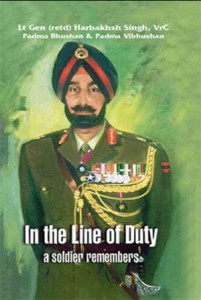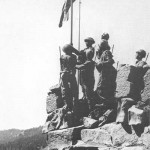Having suffered a rebuff in the Khem Karan Sector, the enemy’s Ace Armoured Division of Pattons was able to transfer, by railway, two regiments of Pattons, through the plains of Lahore, without any interference from our Air Force (you would recall that the fighter planes had been withdrawn from the forward airfields of the Punjab, without my knowledge, to rear bases). They inducted these into the Sialkot Sector. The result was that our 1 Armoured Division was now faced by Pattons.
 1 Armoured Division, after the initial melee on the 8th of September, had gone into a harbour behind village Phillora for the next three days, and it Mcame difficult to get them going. I could not visit this Front till the morning of the 12th of September, because of my close involvement in the Khem Karan Sector. Seeing the mix-up in which I Corps had got involved; I took the General Officer Commanding I Corps to task, on the telephone, for not getting the I Armoured Division going. He said he had received instructions from General Chowdhary, over the telephone, not to stick his head out too much forward! I was aghast and had it out with General Chowdhary, saying that he had no business to give instructions to the General Officer Commanding I Corps as he had been placed under my command. He apologised for this. The General Officer Commanding 1 Corps made a further mess in handling his Forces, and thus Chawinda could not be captured, despite many attempts made by us, and the incurring of heavy casualties, till the cease-fire came into effect.I must mention here certain names and incidents, as they not only vindicate the choice I made of certain persons for certain jobs, but throw light on the acumen and soldierly qualities of the persons so selected.
1 Armoured Division, after the initial melee on the 8th of September, had gone into a harbour behind village Phillora for the next three days, and it Mcame difficult to get them going. I could not visit this Front till the morning of the 12th of September, because of my close involvement in the Khem Karan Sector. Seeing the mix-up in which I Corps had got involved; I took the General Officer Commanding I Corps to task, on the telephone, for not getting the I Armoured Division going. He said he had received instructions from General Chowdhary, over the telephone, not to stick his head out too much forward! I was aghast and had it out with General Chowdhary, saying that he had no business to give instructions to the General Officer Commanding I Corps as he had been placed under my command. He apologised for this. The General Officer Commanding 1 Corps made a further mess in handling his Forces, and thus Chawinda could not be captured, despite many attempts made by us, and the incurring of heavy casualties, till the cease-fire came into effect.I must mention here certain names and incidents, as they not only vindicate the choice I made of certain persons for certain jobs, but throw light on the acumen and soldierly qualities of the persons so selected.
Major Megh Singh. This officer had been commanding a battalion, in the rank of a Lieutenant Colonel, when something happened and he was court-martialled and brought down to Major. He was removed from the command of the battalion and posted to the Training Branch in Headquarters Western Command, at Simla. About a month before the War started with Pakistan, in August, 1965, I was sitting in my office, at Simla, and ruminating over the increasing incidents of violence in Jammu and Kashmir caused by Pakistani personnel who had infiltrated behind the line, when Megh Singh appeared in my office with a request.
He mentioned the dare-devil escapades for which he was known in the past, and asked whether, before retiring from the Army, he could offer his services as an infiltrator behind Pakistani lines. I decided there and then that I would send him to the Corps Commander, Jammu and Kashmir, Lieutenant General Kashmir Katoch, to organise a force of volunteers of his choice with the intention of infiltrating behind the Pakistani Line and carrying out some raids, as a counter to their infiltration, behind our Line. He was very happy with the assignment, and I promised him that if he was successful and shqwed good results, I would be the first to pin the rank of a Lieutenant Colonel on his shoulders. He left very happy, and after I spoke to Kashmir Katoch he was asked to report to him. Before he left, I told Megh that I wanted to keep in touch with him, and that, with the permission of his Corps Commander, to whom I had already spoken, he could contact me directly on the telephone if he needed any help in collecting personnel of his choice.
He was very happy with the assignment, and I promised him that if he was successful and shqwed good results, I would be the first to pin the rank of a Lieutenant Colonel on his shoulders.
Within a few days, I received a telephonl call from him saying that he wanted my permission to enrol Major Bbawani Singh, the Maharaja of Jaipur, in his force. Apparently Bhawani Singh had already signified his willingness to do so. I, however, thought that becoming a member of the infiltration Force, under Megh Singh, was too great a risk for the Maharaja of Jaipur to undertake and so lover-ruled Megh Singh. Incidentally, till date, I have never mentioned this to Lt Col Bhawani Singh, who is now retired from the Army and back in his State.
The ‘Megh Force’, as it came to be called, performed many daring feats behind the enemy lines, which pleased the Corps Commander, Kashmir Katoch. So, when the latter accompanied me to Akhnoor, on the morning of the 4th of September, 1965, and Megh Singh had just returned there, with a bullet in his thigh, from one of his many escapades behind enemy lines, in the presence of his Corps Commander, I pinned the rank of a Lieutenant Colonel on his shoulders.
Brigadier Pritam Singh. He was under a cloud and was lined up to be brought down to Lieutenant Colonel. This was just before the War. I was worried about who would replace the Brigadier in-charge of Dera Baba Nanak, who during a local Exercise had stumbled into one of our own bunkers and broken his back.. I recalled my meeting with Pritam Singh at Dera Baba Nanak, way back in the 1950s, when I was Brigadier General Staff Western Command and he was commanding a Gvards battalion there. He had at the time explained the layout of the sector of Dera Baba N anak to me. So, I sent for him and explained that I was willing to keep him in his present rank of Brigadier if he would go and take over the Dera Baba Nanak bridge. He was only too happy to do so. And though, he did not particularly distinguish himself there, and retired from the Army as a Brigadier, I had the satisfaction of having helped an acquaintance.





GIBRALTAR , BARKI AND MAJ BHATTI’S LAST BATTLE – A VIEW FROM BOTH SIDES
This is relevant here.——
22 —– It therefore is inconsistent with the facts on ground when Lt Col (retd) Syed Shahid Abbas (Nine Crucial Hours – When Courage Outmaneuvered Strength) writes that ‘‘after the declaration of ceasefire on 23 September as per the information received from across the border, the Indians had suffered 400 casualities’’. Equally incongruous is that Gen Harbaksh in his book ‘War Despatches’ (Para 43,Page 49 ) mentions —‘’General Officer Commanding 7 Division appreciating that 48 Infantry Brigade had suffered fairly heavy casualities in the battle for Hudiara Drain, switched 65 Infantry Brigade Group into the lead—‘’ . This was certainly not the case as we shall see later on. Infact the same can be verified from 48 Infantry Brigade records and from the casuality returns of 7 Infantry Division even today.
33 There were casualities on both sides but nothing like the four truckloads of corpses including the dead body of Maj Aziz Bhati—‘’ lifted from the battle field by the Pakistanis after permission was given for collection of their dead.’’ This excerpt as mentioned in Para 47 Page 53 by Gen Harbaksh in his book ‘War Despatches’ needs to be corrected.
Further reading papyrustony.blogspot.in/2014/02/gibraltar-barki-andmaj-bhattis-last.html